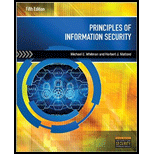
Principles of Information Security
5th Edition
ISBN: 9781285448367
Author: Michael E. Whitman, Herbert J. Mattord
Publisher: Course Technology
expand_more
expand_more
format_list_bulleted
Expert Solution & Answer
Chapter 6, Problem 3E
Explanation of Solution
“No”. There are no any difficulties while implementing the server. The main thing is the configuration would require more effort on their part because this architecture needs more maintenance than others.
- Similarly, place the Web servers, which contain sensitive data inside the network.
Advantages of this implementation:
- Screened subnet architecture with “Demilitarized Zone” is one of the most dominant from other architectures...
Expert Solution & Answer
Trending nowThis is a popular solution!

Students have asked these similar questions
Objective:
1. Implement a custom Vector class in C++ that manages dynamic memory efficiently.
2. Demonstrate an understanding of the Big Five by managing deep copies, move
semantics, and resource cleanup.
3. Explore the performance trade-offs between heap and stack allocation.
Task Description:
Part 1: Custom Vector Implementation
1. Create a Vector class that manages a dynamically allocated array.
。 Member Variables:
°
T✶ data; // Dynamically allocated array for
storage.
std::size_t size; // Number of elements currently
in the vector.
std::size_t capacity; // Maximum number of
elements before reallocation is required.
2. Implement the following core member functions:
Default Constructor: Initialize an empty vector with no allocated storage.
。 Destructor: Free any dynamically allocated memory.
。 Copy Constructor: Perform a deep copy of the data array.
。 Copy Assignment Operator: Free existing resources and perform a deep
copy.
Move Constructor: Transfer ownership of the data array…
2.68♦♦
Write code for a function with the following prototype:
* Mask with least signficant n bits set to 1
* Examples: n = 6 -> 0x3F, n = 17-> 0x1FFFF
* Assume 1 <= n <= w
int lower_one_mask (int n);
Your function should follow the bit-level integer coding rules
Be careful of the case n = W.
Hi-Volt Components
You are the IT manager at Hi-Voltage Components, a medium-sized firm that makes specialized circuit
boards. Hi-Voltage's largest customer, Green Industries, recently installed a computerized purchasing sys-
tem. If Hi-Voltage connects to the purchasing system, Green Industries will be able to submit purchase
orders electronically. Although Hi-Voltage has a computerized accounting system, that system is not
capable of handling EDI.
Tasks
1. What options does Hi-Voltage have for developing a system to connect with Green Industries' pur-
chasing system?
2. What terms or concepts describe the proposed computer-to-computer relationship between
Hi-Voltage and Green Industries?
why not?
3. Would Hi-Voltage's proposed new system be a transaction processing system? Why or
4. Before Hi-Voltage makes a final decision, should the company consider an ERP system? Why or
why not?
Chapter 6 Solutions
Principles of Information Security
Ch. 6 - Prob. 1RQCh. 6 - Prob. 2RQCh. 6 - Prob. 3RQCh. 6 - Prob. 4RQCh. 6 - Prob. 5RQCh. 6 - Prob. 6RQCh. 6 - Prob. 7RQCh. 6 - Prob. 8RQCh. 6 - Prob. 9RQCh. 6 - Prob. 10RQ
Ch. 6 - Prob. 11RQCh. 6 - Prob. 12RQCh. 6 - Prob. 13RQCh. 6 - Prob. 14RQCh. 6 - Prob. 15RQCh. 6 - Prob. 16RQCh. 6 - Prob. 17RQCh. 6 - Prob. 18RQCh. 6 - Prob. 19RQCh. 6 - Prob. 20RQCh. 6 - Prob. 1ECh. 6 - Prob. 2ECh. 6 - Prob. 3ECh. 6 - Prob. 4ECh. 6 - Prob. 5ECh. 6 - Prob. 1CEDQCh. 6 - Prob. 2CEDQCh. 6 - Suppose that Ms. Hamir stacked the deck with her...
Knowledge Booster
Similar questions
- Consider the following expression in C: a/b > 0 && b/a > 0.What will be the result of evaluating this expression when a is zero? What will be the result when b is zero? Would it make sense to try to design a language in which this expression is guaranteed to evaluate to false when either a or b (but not both) is zero? Explain your answerarrow_forwardConsider the following expression in C: a/b > 0 && b/a > 0. What will be the result of evaluating this expression when a is zero? What will be the result when b is zero? Would it make sense to try to design a language in which this expression is guaranteed to evaluate to false when either a or b (but not both) is zero? Explain your answer.arrow_forwardWhat are the major threats of using the internet? How do you use it? How do children use it? How canwe secure it? Provide four references with your answer. Two of the refernces can be from an article and the other two from websites.arrow_forward
- Assume that a string of name & surname is saved in S. The alphabetical characters in S can be in lowercase and/or uppercase letters. Name and surname are assumed to be separated by a space character and the string ends with a full stop "." character. Write an assembly language program that will copy the name to NAME in lowercase and the surname to SNAME in uppercase letters. Assume that name and/or surname cannot exceed 20 characters. The program should be general and work with every possible string with name & surname. However, you can consider the data segment definition given below in your program. .DATA S DB 'Mahmoud Obaid." NAME DB 20 DUP(?) SNAME DB 20 DUP(?) Hint: Uppercase characters are ordered between 'A' (41H) and 'Z' (5AH) and lowercase characters are ordered between 'a' (61H) and 'z' (7AH) in the in the ASCII Code table. For lowercase letters, bit 5 (d5) of the ASCII code is 1 where for uppercase letters it is 0. For example, Letter 'h' Binary ASCII 01101000 68H 'H'…arrow_forwardWhat did you find most interesting or surprising about the scientist Lavoiser?arrow_forward1. Complete the routing table for R2 as per the table shown below when implementing RIP routing Protocol? (14 marks) 195.2.4.0 130.10.0.0 195.2.4.1 m1 130.10.0.2 mo R2 R3 130.10.0.1 195.2.5.1 195.2.5.0 195.2.5.2 195.2.6.1 195.2.6.0 m2 130.11.0.0 130.11.0.2 205.5.5.0 205.5.5.1 R4 130.11.0.1 205.5.6.1 205.5.6.0arrow_forward
- Analyze the charts and introduce each charts by describing each. Identify the patterns in the given data. And determine how are the data points are related. Refer to the raw data (table):arrow_forward3A) Generate a hash table for the following values: 11, 9, 6, 28, 19, 46, 34, 14. Assume the table size is 9 and the primary hash function is h(k) = k % 9. i) Hash table using quadratic probing ii) Hash table with a secondary hash function of h2(k) = 7- (k%7) 3B) Demonstrate with a suitable example, any three possible ways to remove the keys and yet maintaining the properties of a B-Tree. 3C) Differentiate between Greedy and Dynamic Programming.arrow_forwardWhat are the charts (with their title name) that could be use to illustrate the data? Please give picture examples.arrow_forward
- A design for a synchronous divide-by-six Gray counter isrequired which meets the following specification.The system has 2 inputs, PAUSE and SKIP:• While PAUSE and SKIP are not asserted (logic 0), thecounter continually loops through the Gray coded binarysequence {0002, 0012, 0112, 0102, 1102, 1112}.• If PAUSE is asserted (logic 1) when the counter is onnumber 0102, it stays here until it becomes unasserted (atwhich point it continues counting as before).• While SKIP is asserted (logic 1), the counter misses outodd numbers, i.e. it loops through the sequence {0002,0112, 1102}.The system has 4 outputs, BIT3, BIT2, BIT1, and WAITING:• BIT3, BIT2, and BIT1 are unconditional outputsrepresenting the current number, where BIT3 is the mostsignificant-bit and BIT1 is the least-significant-bit.• An active-high conditional output WAITING should beasserted (logic 1) whenever the counter is paused at 0102.(a) Draw an ASM chart for a synchronous system to providethe functionality described above.(b)…arrow_forwardS A B D FL I C J E G H T K L Figure 1: Search tree 1. Uninformed search algorithms (6 points) Based on the search tree in Figure 1, provide the trace to find a path from the start node S to a goal node T for the following three uninformed search algorithms. When a node has multiple successors, use the left-to-right convention. a. Depth first search (2 points) b. Breadth first search (2 points) c. Iterative deepening search (2 points)arrow_forwardWe want to get an idea of how many tickets we have and what our issues are. Print the ticket ID number, ticket description, ticket priority, ticket status, and, if the information is available, employee first name assigned to it for our records. Include all tickets regardless of whether they have been assigned to an employee or not. Sort it alphabetically by ticket status, and then numerically by ticket ID, with the lower ticket IDs on top.arrow_forward
arrow_back_ios
SEE MORE QUESTIONS
arrow_forward_ios
Recommended textbooks for you
 Principles of Information Security (MindTap Cours...Computer ScienceISBN:9781337102063Author:Michael E. Whitman, Herbert J. MattordPublisher:Cengage Learning
Principles of Information Security (MindTap Cours...Computer ScienceISBN:9781337102063Author:Michael E. Whitman, Herbert J. MattordPublisher:Cengage Learning Systems ArchitectureComputer ScienceISBN:9781305080195Author:Stephen D. BurdPublisher:Cengage Learning
Systems ArchitectureComputer ScienceISBN:9781305080195Author:Stephen D. BurdPublisher:Cengage Learning Management Of Information SecurityComputer ScienceISBN:9781337405713Author:WHITMAN, Michael.Publisher:Cengage Learning,
Management Of Information SecurityComputer ScienceISBN:9781337405713Author:WHITMAN, Michael.Publisher:Cengage Learning, Fundamentals of Information SystemsComputer ScienceISBN:9781305082168Author:Ralph Stair, George ReynoldsPublisher:Cengage Learning
Fundamentals of Information SystemsComputer ScienceISBN:9781305082168Author:Ralph Stair, George ReynoldsPublisher:Cengage Learning A+ Guide to Hardware (Standalone Book) (MindTap C...Computer ScienceISBN:9781305266452Author:Jean AndrewsPublisher:Cengage Learning
A+ Guide to Hardware (Standalone Book) (MindTap C...Computer ScienceISBN:9781305266452Author:Jean AndrewsPublisher:Cengage Learning Principles of Information Systems (MindTap Course...Computer ScienceISBN:9781305971776Author:Ralph Stair, George ReynoldsPublisher:Cengage Learning
Principles of Information Systems (MindTap Course...Computer ScienceISBN:9781305971776Author:Ralph Stair, George ReynoldsPublisher:Cengage Learning

Principles of Information Security (MindTap Cours...
Computer Science
ISBN:9781337102063
Author:Michael E. Whitman, Herbert J. Mattord
Publisher:Cengage Learning

Systems Architecture
Computer Science
ISBN:9781305080195
Author:Stephen D. Burd
Publisher:Cengage Learning

Management Of Information Security
Computer Science
ISBN:9781337405713
Author:WHITMAN, Michael.
Publisher:Cengage Learning,

Fundamentals of Information Systems
Computer Science
ISBN:9781305082168
Author:Ralph Stair, George Reynolds
Publisher:Cengage Learning

A+ Guide to Hardware (Standalone Book) (MindTap C...
Computer Science
ISBN:9781305266452
Author:Jean Andrews
Publisher:Cengage Learning

Principles of Information Systems (MindTap Course...
Computer Science
ISBN:9781305971776
Author:Ralph Stair, George Reynolds
Publisher:Cengage Learning